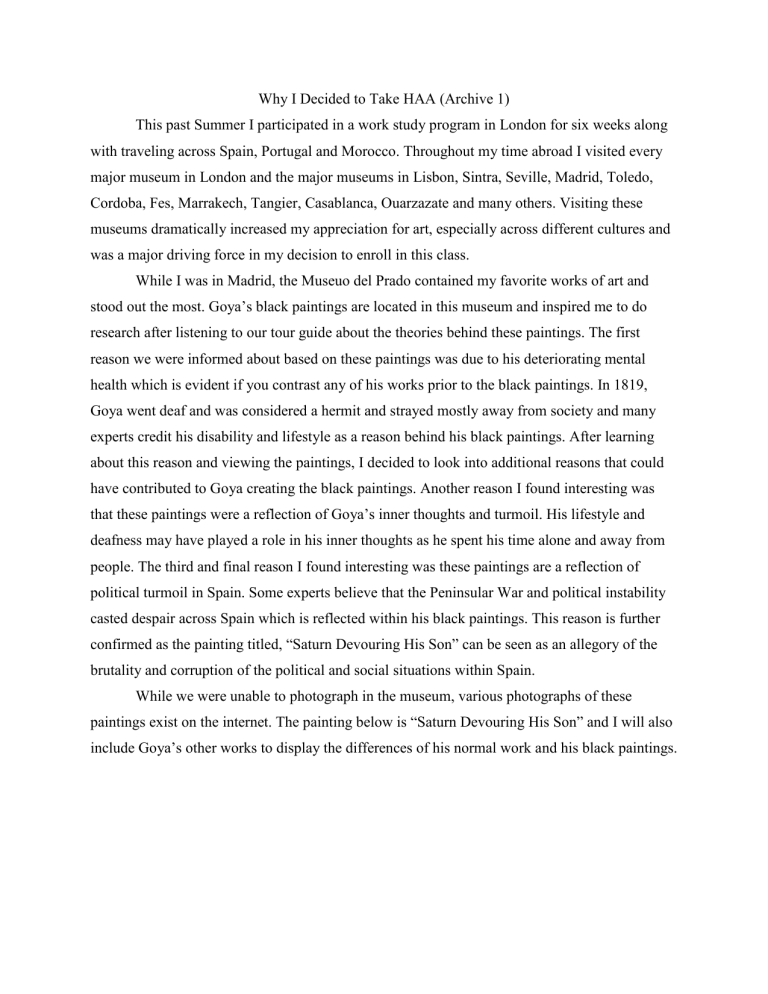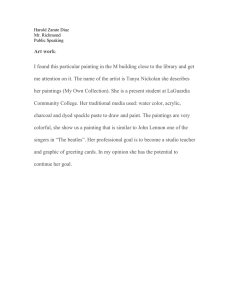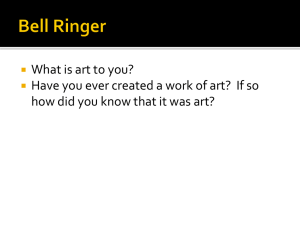
Why I Decided to Take HAA (Archive 1) This past Summer I participated in a work study program in London for six weeks along with traveling across Spain, Portugal and Morocco. Throughout my time abroad I visited every major museum in London and the major museums in Lisbon, Sintra, Seville, Madrid, Toledo, Cordoba, Fes, Marrakech, Tangier, Casablanca, Ouarzazate and many others. Visiting these museums dramatically increased my appreciation for art, especially across different cultures and was a major driving force in my decision to enroll in this class. While I was in Madrid, the Museuo del Prado contained my favorite works of art and stood out the most. Goya’s black paintings are located in this museum and inspired me to do research after listening to our tour guide about the theories behind these paintings. The first reason we were informed about based on these paintings was due to his deteriorating mental health which is evident if you contrast any of his works prior to the black paintings. In 1819, Goya went deaf and was considered a hermit and strayed mostly away from society and many experts credit his disability and lifestyle as a reason behind his black paintings. After learning about this reason and viewing the paintings, I decided to look into additional reasons that could have contributed to Goya creating the black paintings. Another reason I found interesting was that these paintings were a reflection of Goya’s inner thoughts and turmoil. His lifestyle and deafness may have played a role in his inner thoughts as he spent his time alone and away from people. The third and final reason I found interesting was these paintings are a reflection of political turmoil in Spain. Some experts believe that the Peninsular War and political instability casted despair across Spain which is reflected within his black paintings. This reason is further confirmed as the painting titled, “Saturn Devouring His Son” can be seen as an allegory of the brutality and corruption of the political and social situations within Spain. While we were unable to photograph in the museum, various photographs of these paintings exist on the internet. The painting below is “Saturn Devouring His Son” and I will also include Goya’s other works to display the differences of his normal work and his black paintings. As we can see, there is a clear difference in style, theme, and color choices amongst “The Parasol” (1777) and “Saturn Devouring His Son” (1823) and many reasons such as mental and physical health, political turmoil, or Goya’s inner thoughts likely played into reasonings behind his decision to create the black paintings. A Sobering Visit to Earth’s Darkest Chapter (Archive 2) In 2016 I had the privilege of taking a European vacation and exploring the Schengen Area with my family and friends that we met on our tour. Along the way we stopped in Munich which is located near the Dachau concentration camp from World War II. Approaching Dachau was an experience in itself, as I felt connected to the past and felt the coldness emanating from the infamous slogan, “Arbreit Mach Frei.” Chills shouted over me as I entered the camp and there was an immediate change in the atmosphere surrounding our group, almost as if the camp was closing in around us. One thing that struck me about the camp itself was the simple architecture. A simplistic iron gate, wooden barracks, gravel pathways, and long rows of repeating buildings make one wonder how such atrocities could be committed within. I remember touring through multiple barracks and museums all while listening to our guide inform us of the history and not a single person on our tour using their phones, discussing with others, or spacing out to their own world. While being on the tour, two of the most emotionally challenging things I have witnessed have come from firstly the restructured barracks where it was clear the terrible conditions people were forced to endure as there was no bedding, tens of men to a single bunk and unsanitary conditions and next was visiting the gas chambers where millions of lives were taken. The cold, sterile rooms sent a chill down my spine as I was walking through one of the most brutal contractions in human history. In my opinion, there were two major driving forces of why Dachau possessed such a heavy feeling from the weight of history. The first reason being the simple and eerie architecture and the second being the brutalities that were carried out during the Holocaust. The concrete walls topped with barbed wire, simple wooden buildings, organized gravel paths, and intimidating guard towers would lead a person to believe that this was nothing more than a prison. However, the events of history indicate a much darker past that occurred within the walls of Dachau where millions of innocent lives were imprisoned, tortured, and killed. The second reason I believe Dachau was the most humbling memorial I have ever visited is due to the Holocaust. Dachau is seen as a testament of evil and a lesson for humanity to never repeat the events that unfolded during the Holocaust. Archive 3 The process of recreating Jean Arp’s action was a fun activity for me as it has been multiple years since I doodled shapes along with coloring them for a school assignment. The unorganized photo is an assortment of shapes I decided to draw without a single pattern and the colors I decided to use were also randomized. After playing with multiple variations of organizing these shapes, nothing felt sufficient until I put the design together that is pictured above. The reasons behind my decision to reorganize the shapes like this lies in the fact that this was the most aesthetically pleasing assortment of shapes to the human eye. Another reason was that these shapes fit the best in this combination and formed sort of a heart outline by chance. I would say that humanity creativity, decision making, and aesthetic manipulation are all equally important in the creation of a work of art. Randomness is a specific work of art that can appeal to the correct audience but personally, I prefer for art work to have a meaning and a thought out image. In my opinion, a work of art should convey human creativity in the image, creation method, and color scheme to allow the audience to piece together his reasoning behind creating it. A piece of art should also emphasize very specific details that were meticulously put into place by the artist to form certain shapes, people, setting or theme of the work. Finally, aesthetic manipulation is also necessary to create a work of art as it must look like everything is exactly how it is supposed to be. Without the movement of specific shapes to create an image the work of art would appear to be not well thought out, low effort, and a jumble of materials. Human creativity, decision making, and aesthetic manipulation are necessary to create a proper work of art to appeal to the masses, but certain aspects can be ignored if done intentionally and will target another group of people. Comparison of Sunflower Seeds and the Terracotta Army (Archive 4) Ai Weiwei’s “Sunflower Seeds” and the Terracotta Army of Emperor Qin Shi Huang are two drastically different works of art but contain certain similarities. To begin, the scale and quantity of both pieces are very different. In “Sunflower Seeds,” there are millions of small individual seeds but combine to create a vast and immersive piece. On the other hand, the Terracotta Army is made up of thousands of life-sized statues that represent an actual army ranging from soldiers, generals, and horses. In comparison, the vastness of the Terracotta Army is much larger than “Sunflower Seeds” although it is composed of fewer figures. Another way we can compare these two pieces is through their artistic medium. Weiwei’s “Sunflower Seeds” consists of millions of sunflower seeds handcrafted from porcelain, with each seed being unique due to handcrafting. In comparison, the Terracotta Army is an army made up of life-sized soldiers, horses, chariots and other figures that were handcrafted using terracotta clay. A third way that can compare these works of art is through researching their symbolism and why they were created. The Terracotta Army is a symbol of protection for China’s first emperor in the afterlife and sends the message that the afterlife was heavily believed in at the time. After doing a bit of research, “Sunflower Seeds” is a representation of mass production, individuality, and the relationship between the individual and collective in China’s history which is evident through each seed being unique. The fourth and final way that I was able to compare these works of art is through their cultural significance. The Terracotta Army is historically significant in that it tells us a story about ancient Chinese civilization and the beliefs and practices of the Qin Dynasty. Additionally, “Sunflower Seeds” is a modern contemporary work of art and reflects the complex social and political dynamics of modern China. Critical Viewing with a Partner (Archive 5) Earlier in the semester during one of our first art labs, we were tasked with completing a worksheet based on an assigned piece of art with a partner. My partner and I were tasked with critically analyzing and completing a worksheet based on our observations. Our assigned painting was the Madonna col bambino in trono tra santi by Nicola di Maestro Antonio d’Ancona. This painting depicts the Madonna holding baby Jesus, and four men crowding around the throne she is sitting. Among these four men are Saint Leonard, Saint Jerome, John the Baptist and Saint Francis who are all prominent religious figures depicted in the Bible. Upon further inspection of the painting, my partner and I began to point out some religious symbols we recognized and some objects that raised questions. The most prominent symbol we recognized was the lion that accompanies Saint Jerome. Originally, we believed this to be a dog and would not have known it was a lion without guidance which we both found fascinating. The next object that we decided to investigate further was the apple core at the base of her throne. Based on our knowledge of Christianity, we concluded that this apple was meant to represent original sin from Adam and Eve being coerced by the serpent into eating from the Tree of Knowledge which led them to being banished from paradise. Upon learning more about the painting, we were correct in our assumption. The final religious symbol we were able to recognize stood behind the throne with seven angels watching over Madonna and Jesus were present. Typically, in religious paintings, holy figures are depicted with a gold aura or halo around their head symbolizing their connection to the Father, Son and Holy Spirit. Aside from being fascinated by the religious symbolism behind this painting, the grandiose of this piece caught my partner and I’s attention and led us to volunteering to examine it further. This painting covers an entire wall, has a gold wooden border and most of the background is covered by gold. The foreground of this painting also shows a town with people and horses walking along the trails. With this painting being so large, my partner and I enjoyed looking at each aspect and discussing what we believed something could represent. Even after being informed of the symbols, we missed in this painting during our original inspection we still had some leading questions that we could not find the answer to. Our first question relates to the miniature woman underneath Saint Jerome. We were questioning what she could represent, and why she was miniature compared to every other figure in the painting. We also came up with another question regarding the lion. We questioned why the lion had a stick through its paw and was actively bleeding and if this was supposed to represent something we had not considered previously. We found it odd that the lion was being ignored although it was injured and crawling on Saint Jerome’s leg. Garden of Earthly Delights (Archive 6) An artwork that immediately caught my attention was discussed during the “Descent of Ganges and Garden of Earthly Delight” lecture. Hieronymus Bosch’s Garden of Earthly Delights Triptych piqued my attention as it looked so familiar to me. Upon further research, I learned this piece is located at the Museo del Prado in Madrid which I visited this Summer, and this piece was specifically highlighted by our tour guide. With three panels it is technically a triptych but is unlikely to be an altarpiece as each panel’s work is unique and individual. For example, the left panel is depicting the Garden of Eden with God in the foreground creating both Adam and Eve and encouraging them to live in paradise. There is multiple biblical symbolism such as the Tree of Knowledge, along with both Adam and Eve in their idealized forms of possessing graceful proportions. Additionally, the left panel is luminous as the use of bright colors and light is used to create a heavenly atmosphere. On the contrary, the right panel is depicting Bosch’s interpretation of Hell either from the Bible, or a Hell on Earth. This is evident through a nightmarish scene that is a depiction of hellish torments. Additionally, it is a dystopian landscape that is filled with demons, flames, tortured souls, and various distorted monsters. Bosch also depicts Hell through his expressive colors that are dark and intense to convey the evil and ominous atmosphere. After interpreting the middle panel, it is hard to pinpoint a specific biblical reference, but Bosch does a good job of depicting a whimsical scene. Bosch portrays fantastic realism through surreal and imaginative images of various creatures and scenes. The middle panel is also dense with multiple levels of imagery. The background is filled with a surreal landscape featuring hills, bodies of water, and intricate architectural elements which includes domes, and fantastical buildings. The foreground is populated with humanoid and non-humanoid figures who are interacting in activities. There is another body of water in the foreground where some of the figures are engaged in activities. Overall, Bosch made the most of his space in the middle panel to create an imaginative and whimsical scene that is not directly correlated to the Bible like the left and right panels. Trade Canoe for the North Pole (Archive 7) I was interested in learning more about Jaune Quick-to-See Smith and started by looking at her Artist Profile on the National Museum of Women in the Arts website to learn more her as an artist, and her various artistic style. Upon reading her bibliography, I found it interesting to learn that she creates works that address the myths of her ancestors in the context of current issues facing Native Americans especially as she was raised on the Flathead Reservation. Native American art is often overlooked, and I found it fascinating to view her works that incorporate modern issues by drawing inspiration from Picasso, Klee and traditional Native American art. Out of all her pieces of work, Trade Canoe for the North Pole, 2017 stood out as the most interesting for me. From the slideshow, I observed that the piece seemed to be a combination of three different canvases. Additionally, I found it interesting how the canvas in the middle is significantly taller than the other sections. This piece also stood out to me because of the seemingly random collection of masses that are located on the canoe. The bright and vivid colors also drew my attention and caused me to take a deeper look at what this piece entails. After reading about how Jaune Quick-to-See Smith incorporates her ancestors’ myths in the context of current issues facing Native American’s I was able to piece together some observations about this work. On the left side of the canoe, there appears to be a Native American humanoid figure that is upside down. While I am unsure of exactly what it is, it does add an eerie feeling to this piece. The left side of the canoe also has multiple phrases that are difficult to make out aside from “JUST SAY KNOW” and “JustGoWithIt.” I would assume that these relate to how the trade canoes used to bring spoiled goods and resources that carried diseases. I would also like to point out a buffalo figure to the left of the palm tree as the buffalo is typically considered a staple of Native American lifestyle. The middle of the canoe also has Native significance as there appears to be six native warriors who I would consider to be passengers of the canoe. Another thing I noted in the middle of the canoe, but raised some questions for me would be the large humanoid fox. Even after searching on Google, I could not come up with a definite answer which led me to ask these questions. “I noticed foxes typically symbolize companionship in native culture, but what is the meaning of the humanoid version of a fox?” Another question I came up with was, “Is this supposed to be a representation of the people Native American’s typically trade with as they were often taken advantage of and tricked which is typically what a fox represents in literature.” The right side of the canoe also possessed typical native symbols from fire to a horse. Nothing on the right side of the canoe stood out to me like the left side and the middle but there are multiple phrases I cannot make out. I found it interesting that I was drawn to this piece as I typically am not a fan of art that appears to be abstract, but I believe learning about the context enhanced the piece for me. Additionally, I feel like the artist putting various objects together to make a scene that makes sense piqued my interest more than I believed. Nkisi Nkondi (Archive 8) While reflecting and returning to each module to find pieces of art that stood out to me initially, I stumbled upon the Nkisi Nkondi (“Nail Figure”) from an unknown artist in the Kongo. I remember my initial thoughts about this piece were puzzling as I had never seen artwork like this even in Native American art. I found this figure to be quite jarring as it is intimidating and horrifying because of the nails that are embedded in the body and face of the figure. This piece also prompted me to engage in further research as I am interested in viewing other pieces of work along with studying up on vocabulary I am unfamiliar with. The direct translation of Nkisi Nkondi is nail figure which makes sense based on the figure. Upon doing additional research on this piece, I learned that this would be considered a power figure which is supposed to be a magical charm seemingly carved in the likeness of a human being and is meant to highlight its function in human affairs Harris, Klemm 2015). Also in this article, I learned that Nkisi Nkondi figures are not a singular piece of art but instead a whole collection of highly recognizable figures through an accumulation of pegs, blades, nails or other sharp objects inserted into its surface. I was also interested in learning if the nails represented anything significant or if they were just there to signify protection as I originally believed. From the same article, I was informed that the nails are driven into the figure by the nganga which translates to “expert” and represent the mambu which I believe translates to an issue under discussion or argument. Each of these nails are also representational of an argument being solved and the depth at which they are inserted signifies the severity of the argument. Finally, this article also mentions how the nails are licked prior to insertion to seal the purpose of the nkisi through their saliva which I found fascinating. My favorite aspect of reflecting on older modules is delving into research and learning what a specific piece actually signifies especially when it comes from a culture I am unfamiliar with. I love traveling and learning all different artist perspectives when I visit museums as different cultures think differently when it comes to art and this is no different. If you are interested in reading the article I found this information from, here is the link: https://smarthistory.org/nkisi-nkondi-kongo-people/ Easter Island and Moai Statues (Archive 9) One of the most recognizable wonders of the art world is located on Easter Island with the Moai sculptures. Rapa Nui is five to six hours by airplane and over 2,200 miles west of Chile, and 2,500 miles from Tahiti. The Polynesian settlers who arrived in Rapa Nui around 400 CE began erecting the Moai figures that remain on the island. I have never conducted a deep dive on research on the Moai figures but a theory I always find interesting relates to extraterrestrial intervention in carving and relocating the figures to their current positions. The posted guide on the Moai states that the carvings were transported upright, shimmied on log rollers, and have the appearance of walking as they were transported slowly. While this theory would make sense, I would like to raise a question. As these carvings are massive and weigh tons, why would settlers of Rapa Nui decide to carve them so far away from where they would be standing? I would also like to ask, why continue to make these figures for centuries as compared to shrinking the size to reduce the number of resources, effort, and labor for each one. Continuing reading through the guide on the Moai, it assumes that most of the figures are male, however some exhibit lines in the groin area the are thought to depict vulva. Another question I came up based on this information is, what is the reason these figures would represent a sex instead of representing a sexless deity that would offer them protection like I had assumed they represented. Additionally, I found it interesting that the Moai statues were more than a head and possessed full bodies with odd proportions. After reading more of the posted guide, I wonder why each Moai possesses different traits such as a vulva, elongated earlobes, necklaces, and odd body proportions. My final question regarding the Moai is, are the Moai figures supposed to represent some kind of deity that is worshipped in Polynesian culture or if they are just a representation of a random collection of traits from their culture?







